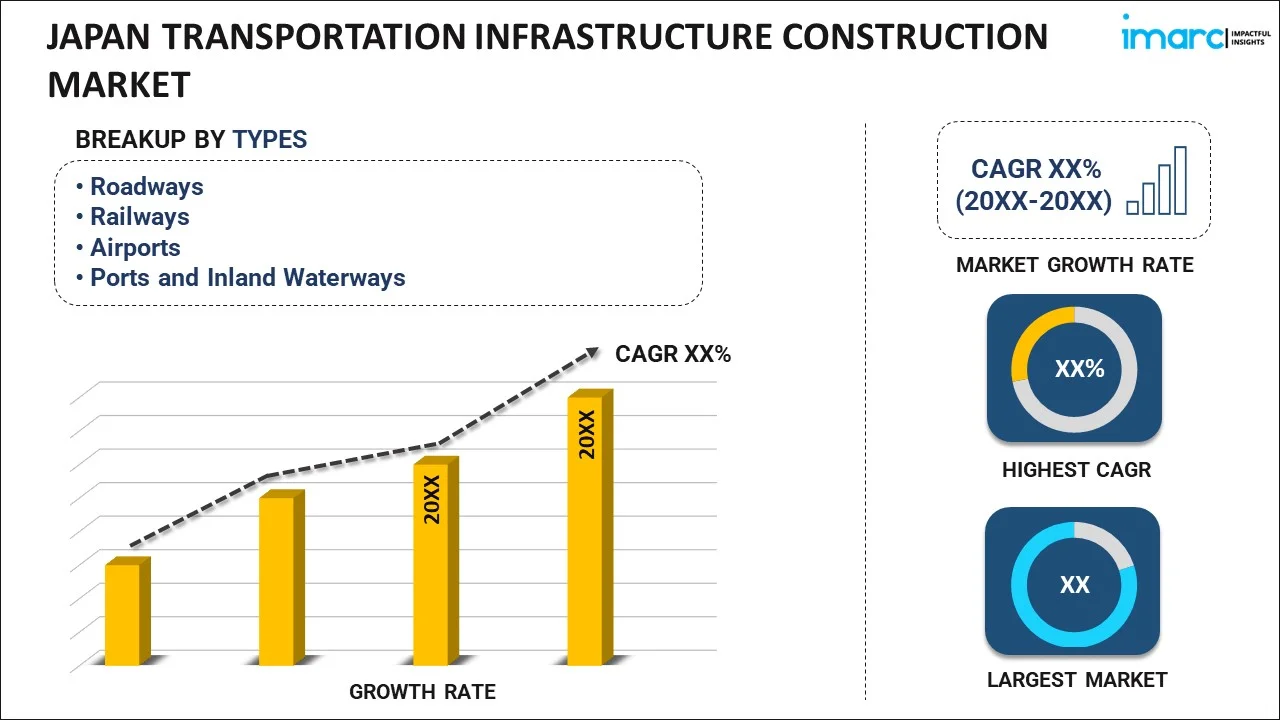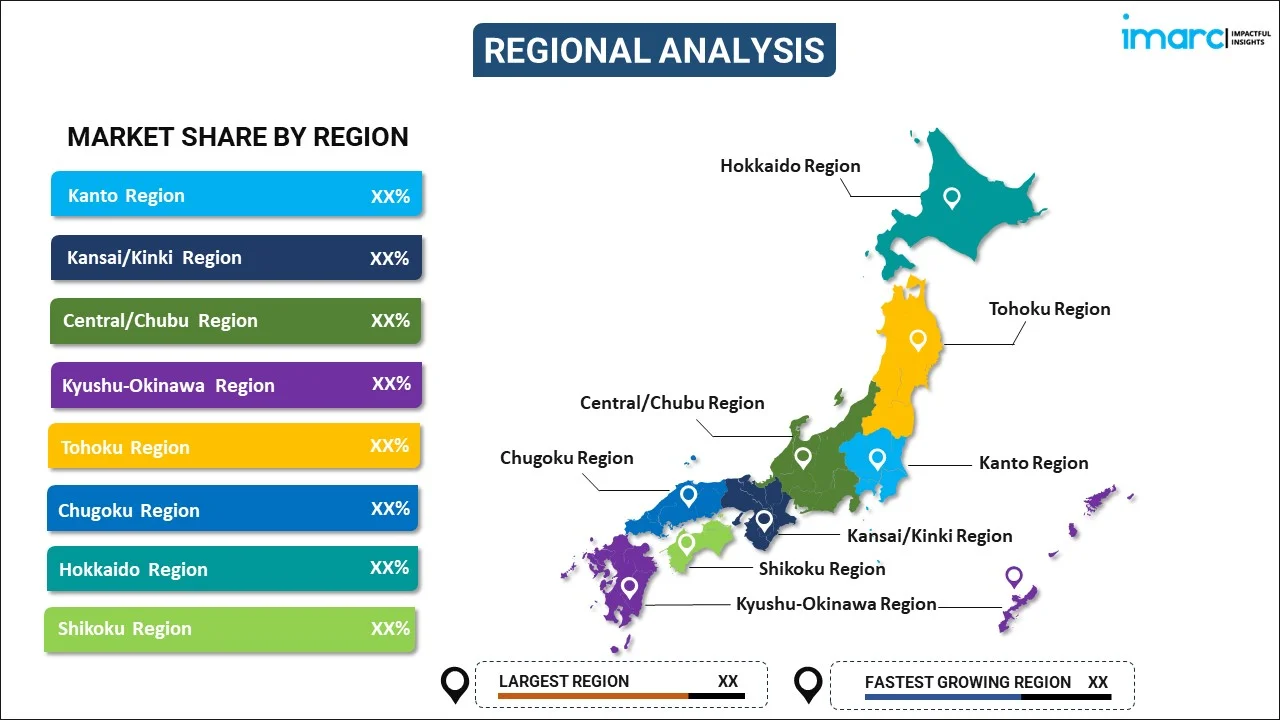
Japan Transportation Infrastructure Construction Market Report by Type (Roadways, Railways, Airports, Ports and Inland Waterways), and Region 2026-2034
Market Overview:
Japan transportation infrastructure construction market size reached USD 10.0 Billion in 2025. Looking forward, IMARC Group expects the market to reach USD 15.0 Billion by 2034, exhibiting a growth rate (CAGR) of 4.66% during 2026-2034. Government initiatives, international events, and the growing focus on boosting tourism represent some of the key factors driving the market growth.
|
Report Attribute
|
Key Statistics
|
|---|---|
|
Base Year
|
2025
|
|
Forecast Years
|
2026-2034
|
|
Historical Years
|
2020-2025
|
|
Market Size in 2025
|
USD 10.0 Billion |
|
Market Forecast in 2034
|
USD 15.0 Billion |
| Market Growth Rate 2026-2034 | 4.66% |
Transportation infrastructure construction serves as the backbone of modern societies, facilitating seamless movement of goods, people, and information. It encompasses a wide range of projects, including roads, bridges, tunnels, railways, airports, and seaports. Properly planned and executed infrastructure not only ensures efficient mobility but also spurs economic growth, enhances regional connectivity, and reduces transportation costs. In the recent times, innovations in materials and engineering practices have paved the way for more resilient and sustainable transport networks. Amid growing concerns over climate change and urbanization, there is an increasing emphasis on integrating eco-friendly materials and smart technologies into infrastructure development.
Japan Transportation Infrastructure Construction Market Trends:
The Japan transportation infrastructure construction market stands out as a confluence of innovation, precision, and resilience. Historically, the country’s intricate and efficient network of shinkansen (bullet trains), urban subways, expressways, and airports have made it a model for other nations. In recent years, the focus has shifted towards enhancing durability and sustainability, especially given the country's susceptibility to natural disasters like earthquakes and tsunamis. Cutting-edge seismic engineering techniques are now standard in infrastructure projects to ensure longevity and safety. Additionally, with urban areas like Tokyo facing space constraints, underground and multi-level transportation solutions are gaining traction. Sustainability is another key trend; Japan is integrating renewable energy sources and energy-efficient technologies into its infrastructure. This is evident in the construction of eco-friendly train stations and the use of energy-saving train models. As for market drivers, the upcoming global events such as the previously postponed Tokyo Olympics and the anticipated increase in tourism post-pandemic are spurring infrastructural upgrades and expansions. Besides this, the government's push towards regional revitalization is also playing a role, redirecting focus from major cities to smaller towns and ensuring a more evenly distributed transportation network. Furthermore, Japan's commitment to reducing its carbon footprint has resulted in investments in cleaner public transportation options and a gradual shift away from vehicles reliant on fossil fuels, which is expected to fuel the regional market over the forecasted period.
Japan Transportation Infrastructure Construction Market Segmentation:
IMARC Group provides an analysis of the key trends in each segment of the market, along with forecasts at the country level for 2026-2034. Our report has categorized the market based on type.
Type Insights:

- Roadways
- Railways
- Airports
- Ports and Inland Waterways
The report has provided a detailed breakup and analysis of the market based on the type. This includes roadways, railways, airports, and ports and inland waterways.
Regional Insights:

- Kanto Region
- Kansai/Kinki Region
- Central/ Chubu Region
- Kyushu-Okinawa Region
- Tohoku Region
- Chugoku Region
- Hokkaido Region
- Shikoku Region
The report has also provided a comprehensive analysis of all the major regional markets, which include Kanto Region, Kansai/Kinki Region, Central/ Chubu Region, Kyushu-Okinawa Region, Tohoku Region, Chugoku Region, Hokkaido Region, and Shikoku Region.
Competitive Landscape:
The market research report has also provided a comprehensive analysis of the competitive landscape in the market. Competitive analysis such as market structure, key player positioning, top winning strategies, competitive dashboard, and company evaluation quadrant has been covered in the report. Also, detailed profiles of all major companies have been provided.
Japan Transportation Infrastructure Construction Market Report Coverage:
| Report Features | Details |
|---|---|
| Base Year of the Analysis | 2025 |
| Historical Period | 2020-2025 |
| Forecast Period | 2026-2034 |
| Units | Billion USD |
| Scope of the Report | Exploration of Historical and Forecast Trends, Industry Catalysts and Challenges, Segment-Wise Historical and Predictive Market Assessment:
|
| Types Covered | Roadways, Railways, Airports, Ports and Inland Waterways |
| Regions Covered | Kanto Region, Kansai/Kinki Region, Central/ Chubu Region, Kyushu-Okinawa Region, Tohoku Region, Chugoku Region, Hokkaido Region, Shikoku Region |
| Customization Scope | 10% Free Customization |
| Post-Sale Analyst Support | 10-12 Weeks |
| Delivery Format | PDF and Excel through Email (We can also provide the editable version of the report in PPT/Word format on special request) |
Key Questions Answered in This Report:
- How has the Japan transportation infrastructure construction market performed so far and how will it perform in the coming years?
- What has been the impact of COVID-19 on the Japan transportation infrastructure construction market?
- What is the breakup of the Japan transportation infrastructure construction market on the basis of type?
- What are the various stages in the value chain of the Japan transportation infrastructure construction market?
- What are the key driving factors and challenges in the Japan transportation infrastructure construction?
- What is the structure of the Japan transportation infrastructure construction market and who are the key players?
- What is the degree of competition in the Japan transportation infrastructure construction market?
Key Benefits for Stakeholders:
- IMARC’s industry report offers a comprehensive quantitative analysis of various market segments, historical and current market trends, market forecasts, and dynamics of the Japan transportation infrastructure construction market from 2020-2034.
- The research report provides the latest information on the market drivers, challenges, and opportunities in the Japan transportation infrastructure construction market.
- Porter's five forces analysis assist stakeholders in assessing the impact of new entrants, competitive rivalry, supplier power, buyer power, and the threat of substitution. It helps stakeholders to analyze the level of competition within the Japan transportation infrastructure construction industry and its attractiveness.
- Competitive landscape allows stakeholders to understand their competitive environment and provides an insight into the current positions of key players in the market.
Need more help?
- Speak to our experienced analysts for insights on the current market scenarios.
- Include additional segments and countries to customize the report as per your requirement.
- Gain an unparalleled competitive advantage in your domain by understanding how to utilize the report and positively impacting your operations and revenue.
- For further assistance, please connect with our analysts.
 Request Customization
Request Customization
 Speak to an Analyst
Speak to an Analyst
 Request Brochure
Request Brochure
 Inquire Before Buying
Inquire Before Buying




.webp)




.webp)












